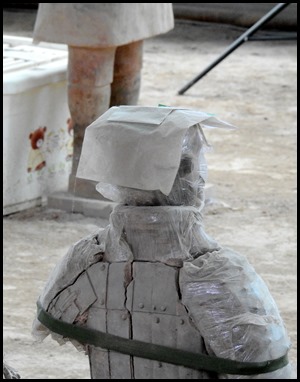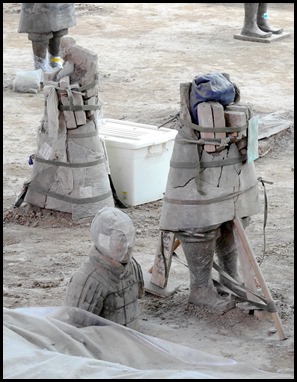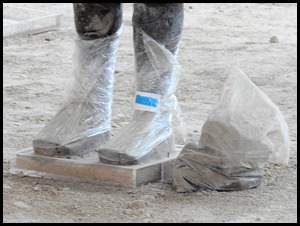TA Pit 1 - ICU

|
Terracotta Army Pit 1 - Intensive Care Unit and
Hospital  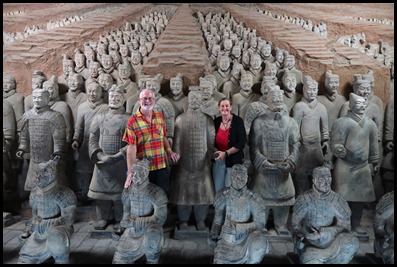 On entering Pit 1 we were quickly in
WOW mode. Birthday Boy posed with the chaps behind
him and later (in Pit 3) we had our ‘pretend’ picture
taken.
 The vanguard at
the front of Pit 1 held our interest and we simply could not get over the
size of the ‘hangar’ we were in.
  Further back in the columns we saw the
condition of some partially unearthed chaps as well
as a group in much better condition.
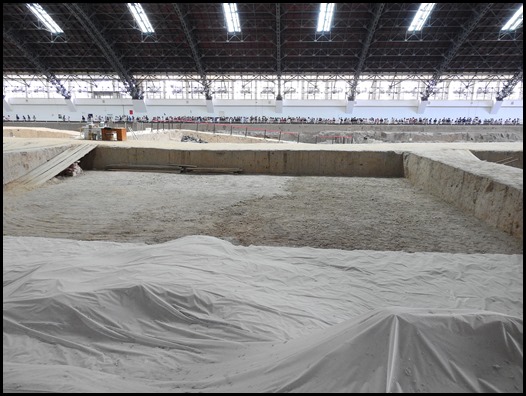 About half way through the ‘hangar’
was a no-man’s land where work has yet to begin save
the first few feet of earth having been removed.
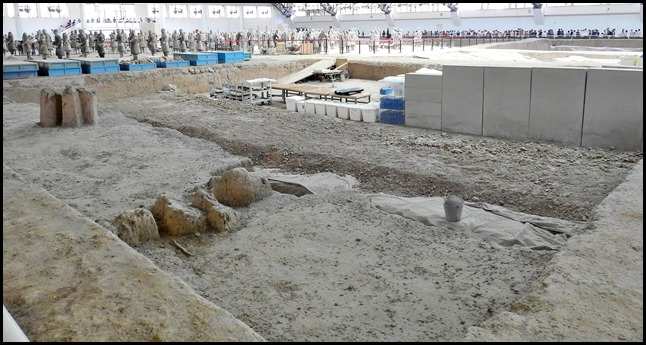 A bit further on and an area of work in progress.
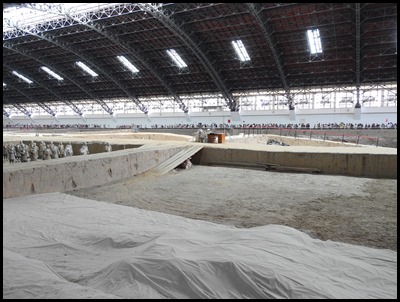  Behind that area we got our first
look at the ‘mostly renovated’, each statue with his number on his chest, ready to go back
from whence he came, this time standing proudly instead of laying messily with
his comrades.
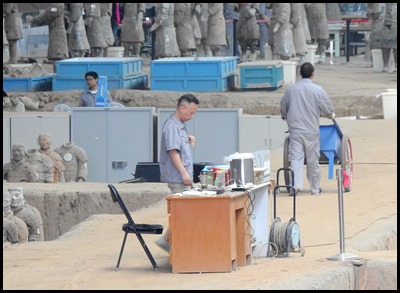  We loved the desk
in the middle, clearly a well-used old friend.
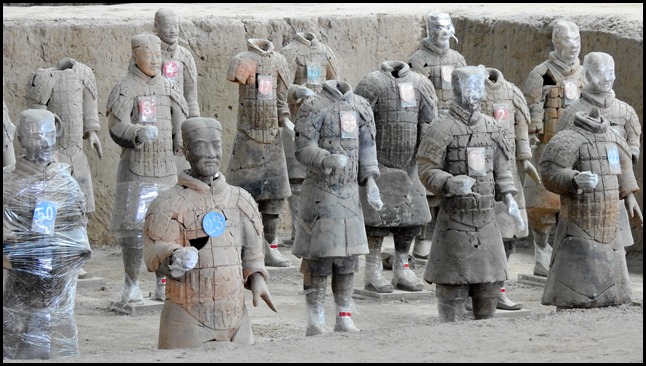 The next area along, chaps with
numbers but many with heads missing and several big
holes.
Whilst researching for this blog I
came across an article written in 2014 on the NPC Site. I thank them for such an
interesting piece. It reads:
When we talk about the terracotta army, most of us probably picture the legions of lifelike stone soldiers. But when they were first discovered, they were broken into thousands of pieces. So how were they restored to their former glory? The magnificent sight of the Terracotta Warriors has drawn countless tourists to the ancient city of Xi’an. But they didn’t look like this when they were first unearthed. The restoration was a complicated and painstaking process, that required the steady hands of veteran archaeologists. First, the fragments have to be thoroughly cleaned before even attempting to put them back together. Lan Desheng, from restoration centre of Museum of Qin Shihuang Imperial Mausoleum says, "We do the work very slowly. While cleaning them, we use bamboo picks in order not the damage the colourful paintings on the relics and also to avoid the scraping the surface. It is extremely difficult when it comes to ones that feature leather or colour paintings on the surface, because it’s very easily damaged or contaminated. For coloured ceramic relics, there are 19 kinds of contamination which can erode the ceramics on the relics here we’ve found 18 of them. If the contamination isn’t cleaned up thoroughly, the relics will be further eroded in the future.
The cleaning process is just the first step. Assembling the thousands of fragments is even more complicated. It’s vital to keep track of all the valuable historical information that might be revealed by the fragments, so workers have to number and analyse each and every one of them. In order to keep accurate records, a good system is key. Lan Desheng says, "For very damaged piece, we give them big numbers, and for comparatively complete pieces, we give them a small number. For example, this piece of terracotta, the name for it is T23G924, number is 36." Based on the analysis of all the fragments, archaeologists can figure out which fragment belongs to which statue. Then it’s time to begin reconstructing the statues from the shattered pieces. What a wonderful job if you love 3D jigsaws.
Lan says, "Firstly, we try to patch up the fragments of the main statues and see which pieces fit. We begin from the pedestals, and then the feet, the ends of gowns, then the body, then the head. That means going from bottom to top. The secrets lies in finding the right places to make the connection. If you do that right everything will start falling into place. " It can take a lot of unsuccessful attempts before finding the right combination. Once the right connection is found, work can begin on grafting them to the main body. All these warriors and horses are life-sized, so it is impossible to put them all together at once. The experts have to start from the smallest body parts and work their way up to the biggest. Lan says, "The bonding process is the most important job. If the bonding goes well, the terracotta will be nice and firm. Otherwise, some of them collapse again within a few years. We use dual epoxy resin, layer by layer, to bond them. It takes 24 hours to harden." Normally, for a badly damaged statue, it takes 3 to 5 months to complete the restoration. So far, archaeological workers in this centre have already restored more then 1,000 statues. Thanks to their hard work, the great army of the Qin emperor might one day be completely restored to its former glory.  A bit further along. We called this
the High Dependency area.
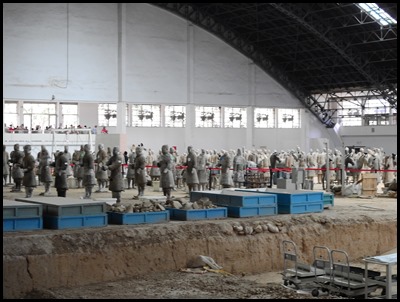  At the far end was the ICU. Here were many warriors
and boxes of parts to be sorted,
 Morning
meeting of a group of archaeologists in progress.
 Someone’s
workbench.
 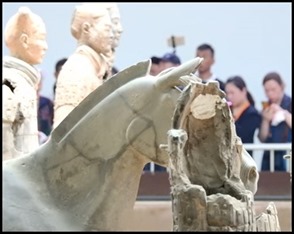 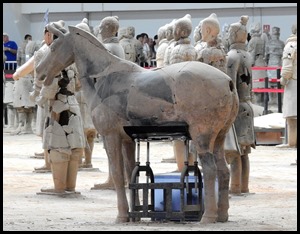  Equine intensive
care.
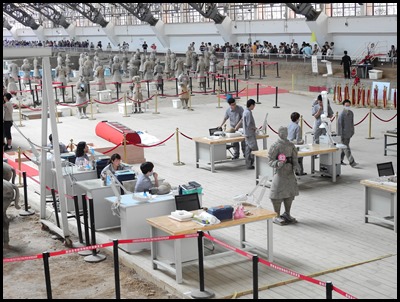 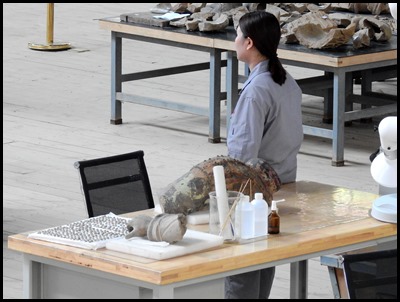 Busy
workers and a lady taking a break from working on a
hand, hundreds of bits laid out in front.
The sign read: Conservation and
Restoration Open Workshop. The Open Workshop was established in 2015 with
sponsorship from Xian Janssen Pharmaceutical Ltd. It aims to show the actual
process of restoring cultural relics and natural and human sciences involved;
giving viewers the chance to take a closer look at the conservation and
restoration process behind the glass barrier.
Since 2000, Xian Janssen has
collaborated with the Emperor Qin’s Museum of Terracotta Warriors and Horses to
aid the preservation of this magnificent relic by providing the museum with
research facilities, anti-fungal treatments, employee training and a first-class
microbial laboratory for advanced material protection research in
China. Valerie Singleton at the top of
her game methinks.
  Incredible to be able to stand and
watch the many workers for a while.
 The size of this
project.......... is simply mind-blowing.
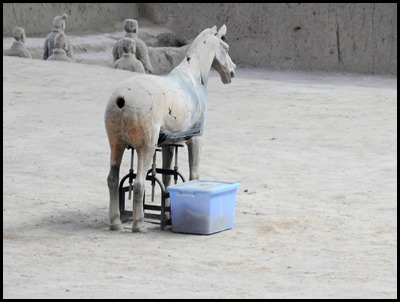 This poor Neddy is in the Isolation Unit......
 It’s hard to process the sheer numbers involved in the restoration. This group were fairly intact but holes and missing bits yet to be
finished.
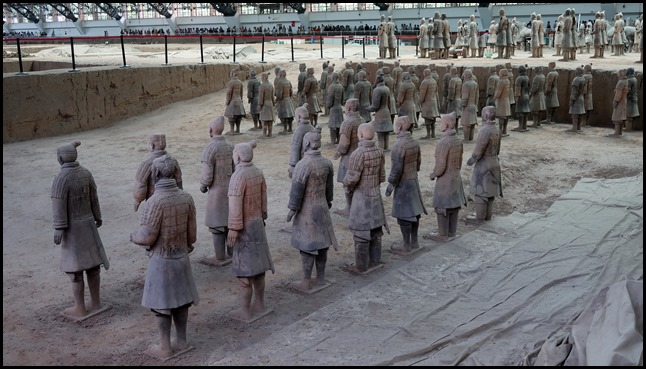 All the hard work has paid off for this group near the corner, just
a little physio required.
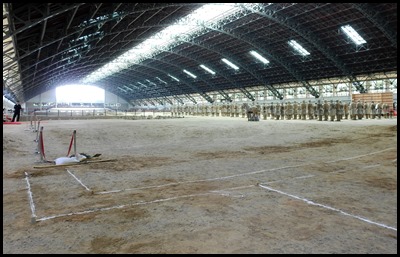  We walked to the far corner to see a
huge area marked out for a future dig. Back to ICU
for a final look. Both of us agreed this experience
is a “not to be missed” and what a way to spend a
birthday, amazing to be here and most incredible to me is the fact that there
was not a single intact warrior found.
ALL IN ALL SUCH DEDICATION
AND PATIENCE
FASCINATING TO
SEE |
